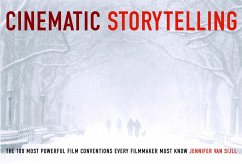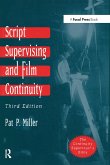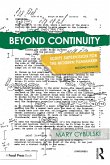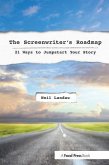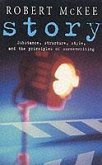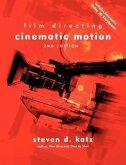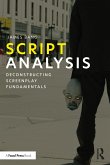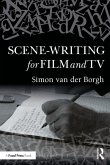How do directors use screen direction to suggest conflict? How do screenwriters exploit film space to show change? How does editing style determine emotional response?
Many first-time writers and directors do not consider this. They forgo the huge creative resource of the film medium defaulting instead to dialog and narration to tell their screen story. Yet most movies are carried by sound and picture. What the industry's most successful writers and directors have in common is that they have mastered the cinematic conventions specific to the medium. They have harnessed non-dialog techniques to create some of the most cinematic moments in movie history.
This book is intended to help writers and directors more fully exploit the medium's storytelling techniques. It contains 100 non-dialog techniques that have been used by the industry's top writers and directors. From 'Metropolis' and 'Citizen Kane' to 'Dead Man' and 'Kill Bill', the book illustrates - through 500 frame grabs and 75 script excerpts - how the inherent stortytelling devices specific to film were exploited.
Learn how non-dialogue film techniques can advance story
Discover how master screenwriters exploit cinematic conventions to create powerful scenarios
Brilliantly illustrated throughout with 500carefully chosen frame grabs from classic films of the past and present
Hinweis: Dieser Artikel kann nur an eine deutsche Lieferadresse ausgeliefert werden.
Many first-time writers and directors do not consider this. They forgo the huge creative resource of the film medium defaulting instead to dialog and narration to tell their screen story. Yet most movies are carried by sound and picture. What the industry's most successful writers and directors have in common is that they have mastered the cinematic conventions specific to the medium. They have harnessed non-dialog techniques to create some of the most cinematic moments in movie history.
This book is intended to help writers and directors more fully exploit the medium's storytelling techniques. It contains 100 non-dialog techniques that have been used by the industry's top writers and directors. From 'Metropolis' and 'Citizen Kane' to 'Dead Man' and 'Kill Bill', the book illustrates - through 500 frame grabs and 75 script excerpts - how the inherent stortytelling devices specific to film were exploited.
Learn how non-dialogue film techniques can advance story
Discover how master screenwriters exploit cinematic conventions to create powerful scenarios
Brilliantly illustrated throughout with 500carefully chosen frame grabs from classic films of the past and present
Hinweis: Dieser Artikel kann nur an eine deutsche Lieferadresse ausgeliefert werden.
"What a fascinating book for a scriptwriter to read! Van Sijll's layout and logical progression through the different elements of film, from frame composition to locations and lighting, are easy to follow and almost Zen-like in their simplicity. Despite that simplicity, they do make an impact and stay with you long after you've put the book down...This is straightforward instruction presented in an easy-to-follow way." - www.scriptmag.com
"This book is highly recommended to anyone who currently works in the camera department, editors, scriptwriters, sound designers, directors and many more." - British Cinematographer
"Van Sijlls analysis is often brilliant - the discussions of Psycho, Cabaret, Apocalypse Now and Barton Fink are superb. Her illustrations of dramatic value are insightful." - Writer's Guild
"The films provide not only practical explanations, but give you enough desire to go and widen your film collection." - Black Filmmaker
"This book belongs on the shelf of anyone interested or involved in filmmaking, storyboarding, camerawork, cinematography, producing, and/or directing. Too many filmmakers--both microcinema and "big Hollywood"--don't fully understand the purposes and implications of various shots; this book will help you make the best use of your time, equipment, story, planning, and ideas." - www.microfilmmaker.com
"This book is crammed full of stills from the movies and will give you the cinematic vocabulary to tell your stories eloquently and with great succinctness. Clearly illustrated throughout, this book is the business. If narrative film is your bag then this is your book." - Focus
"Setting Up Your Story Cinematically" scores a direct hit in terms of concise information and perfectly chosen visuals, and it also searches out... and finds... an emotional core that many books of this nature either miss or are afraid of."
- Kirsten Sheridan, Director, 'Disco Pigs'; Co-writer, In America
"Here is a uniquely fresh, accessible, and truly original contribution to the field. Jennifer van Sijll takes her readers in a wholly new direction, integrating aspects of screenwriting with all the film crafts in a way I've never before seen. It is essential reading not only for screenwriters but also for filmmakers of every stripe."
- Prof. Richard Walter, UCLA Screenwriting Chairman
"This book is highly recommended to anyone who currently works in the camera department, editors, scriptwriters, sound designers, directors and many more." - British Cinematographer
"Van Sijlls analysis is often brilliant - the discussions of Psycho, Cabaret, Apocalypse Now and Barton Fink are superb. Her illustrations of dramatic value are insightful." - Writer's Guild
"The films provide not only practical explanations, but give you enough desire to go and widen your film collection." - Black Filmmaker
"This book belongs on the shelf of anyone interested or involved in filmmaking, storyboarding, camerawork, cinematography, producing, and/or directing. Too many filmmakers--both microcinema and "big Hollywood"--don't fully understand the purposes and implications of various shots; this book will help you make the best use of your time, equipment, story, planning, and ideas." - www.microfilmmaker.com
"This book is crammed full of stills from the movies and will give you the cinematic vocabulary to tell your stories eloquently and with great succinctness. Clearly illustrated throughout, this book is the business. If narrative film is your bag then this is your book." - Focus
"Setting Up Your Story Cinematically" scores a direct hit in terms of concise information and perfectly chosen visuals, and it also searches out... and finds... an emotional core that many books of this nature either miss or are afraid of."
- Kirsten Sheridan, Director, 'Disco Pigs'; Co-writer, In America
"Here is a uniquely fresh, accessible, and truly original contribution to the field. Jennifer van Sijll takes her readers in a wholly new direction, integrating aspects of screenwriting with all the film crafts in a way I've never before seen. It is essential reading not only for screenwriters but also for filmmakers of every stripe."
- Prof. Richard Walter, UCLA Screenwriting Chairman

